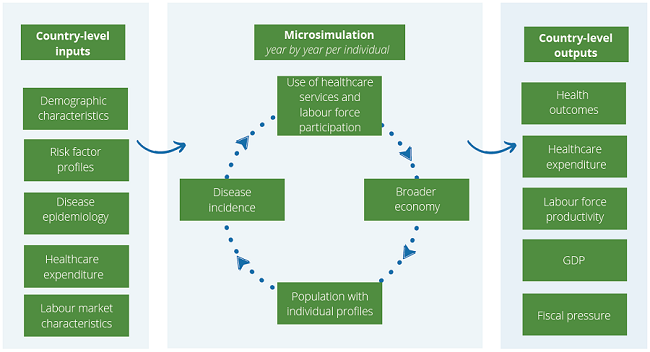Santé
Modelling work in public health: the OECD’s SPHeP models
|
|
|
Introducing the SPHeP Models
Our models produce evidence that can guide policy decisions on how to ensure that resources spent on public health policy actions will produce the greatest health outcomes and economic benefits. They are designed to generate data on how to prevent, manage and control key public health threats. This includes the vast majority of non-communicable diseases, injuries and mental health problems, as well as emerging threats in the field of communicable diseases.
The OECD has developed two advanced system-modelling tools to cover all the areas of public health:
- A microsimulation model, which covers all the key threats related to non-communicable diseases. These include diabetes, cancers and cardiovascular diseases, in addition to injuries and mental health issues, as well as key risk factors such as harmful alcohol consumption, unhealthy diet, physical inactivity and tobacco use. In total, the model accounts for more than 26 diseases and 6 risk factors, which represent the vast majority of the burden of disease.
- An agent-based model, to simulate dynamics specific to communicable diseases. So far, the OECD is applying this methodology to antimicrobial resistance (AMR) and COVID-19, but the framework can be broadly applicable to all communicable diseases.
OECD work covers more than 50 countries - all the 37 OECD member countries, the other non-OECD EU and G20 countries, as well as other key partners of the OECD - accounting for more than 4.7 billion people (over 60% of the world's population) and nearly 80% of the world economy. The models can easily be adapted to cover any country in the world.
KEY ISSUES
The models help policy-makers respond to the following questions:
- What would be the investment needed to implement or scale up a specific public health programme?
- What would be the impact of this intervention in terms of population health and healthcare expenditure?
- What would be the effects of the new programme on labour force productivity and the economy (i.e. GDP)?
- What is the return on investment of the policy action and its distributional impact?
- How long will it take to produce the desired effects?
Inputs and outputs of the SPHeP models
FURTHER READING
The following projects are heavily based on our models:
- Read the OECD Health Working Paper No. 155 - Évaluation du programme national de lutte contre le tabagisme en France (June 2023) - in French only, English version to be released soon
- Read our 2023 AMR report Embracing a One Health Framework to Fight Antimicrobial Resistance
- Read our 2021 report on alcohol Preventing Harmful Alcohol Use (May 2021). Access the previous report Tackling Harmful Alcohol Use: Economics and Public Health Policy (May 2015)
- Read the 2019 obesity report The Heavy Burden of Obesity: The Economics of Prevention
- Read the 2018 AMR report Stemming the Superbug Tide: Just A Few Dollars More
- Access the data visualisation tool at http://oecdpublichealthexplorer.org/
- Find out more about our work on Public Health
- Health Statistics
- Health Publications
CONTACT
For more information, please contact Mr Michele Cecchini at michele.cecchini@oecd.org or health.contact@oecd.org

Follow us on Twitter @OECD_Social
Documents connexes

